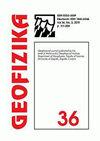Comparison of expert, deterministic and Machine Learning approach for landslide susceptibility assessment in Ljubovija Municipality, Serbia
IF 1.1
4区 地球科学
Q4 GEOCHEMISTRY & GEOPHYSICS
引用次数: 11
Abstract
Landslide Susceptibility Assessment is becoming a very productive research area, wherein different modeling approaches are practiced to delineate zones of the high-low likelihood of landslide occurrence. However, there is no strong consensus on which approach is the most adequate. The reason behind the lack of the general view on the performance of different approaches could be partially explained by the particularity of each study. To evaluate the efficiency of different approaches they need to be applied under the same conditions for the same study area. Herein, we examined three different approaches, including expert, deterministic and Machine Learning, on the example of Ljubo-vija Municipality in western Serbia. The study area has been known as susceptible to landslides, and represents good ground for assessing the chosen methods. It is represented by complex geology, prone to landslides that are commonly hosted in thick weathering crust of Paleozoic formations, composed of schists and meta-sediments. Under extreme triggering conditions, such as the one that unfolded in May 2014, these thick weathering crusts saturate, and give way to a variety of landslide and flash-flood processes that we will be focusing on in this study. The application of the expert-approach, through Analytical Hierarchy Process provided a rough assessment map. The deterministic model, which couples simple infinite slope and hydrological model, provided us with lower quality results, when compared to the expert-based one. This could be explained by the assumptions used in the model are too simplistic to generically model a wide range of landslide typology. Finally, Machine Learning approach, using the Random Forest algorithm, provided significantly better results and showed that it can cope with versatile landslide typology over larger scales. Its AUC performance is about 0.75 which is considerably outperforming the AUC values of the other two models, which were up to 0.55, i.e. at the level of random guess.专家、确定性和机器学习方法在塞尔维亚Ljubovija市滑坡易感性评估中的比较
滑坡易感性评价正在成为一个非常富有成效的研究领域,其中采用不同的建模方法来划定高-低滑坡发生可能性的区域。然而,对于哪种方法是最适当的,并没有强有力的共识。对不同方法的表现缺乏总体看法的原因可以部分地解释为每个研究的特殊性。为了评估不同方法的效率,需要在同一研究区域的相同条件下应用这些方法。本文以塞尔维亚西部Ljubovija市为例,研究了三种不同的方法,包括专家、确定性和机器学习。众所周知,该研究地区易受滑坡影响,为评估所选方法提供了良好的基础。地质条件复杂,山体滑坡易发,一般赋存于由片岩和变质沉积物组成的古生代地层的厚风化壳中。在极端触发条件下,如2014年5月展开的那次,这些厚厚的风化壳饱和,并让位于各种滑坡和山洪暴发过程,我们将在本研究中重点关注这些过程。运用专家法,通过层次分析法提供了粗略的评价图。与基于专家的模型相比,将简单的无限斜率和水文模型耦合在一起的确定性模型提供的结果质量较低。这可以解释为模型中使用的假设过于简单,无法对广泛的滑坡类型进行一般建模。最后,使用随机森林算法的机器学习方法提供了明显更好的结果,并表明它可以在更大的尺度上应对多种滑坡类型。其AUC性能约为0.75,显著优于其他两个模型的AUC值,后者的AUC值高达0.55,即在随机猜测水平。
本文章由计算机程序翻译,如有差异,请以英文原文为准。
求助全文
约1分钟内获得全文
求助全文
来源期刊

Geofizika
地学-地球化学与地球物理
CiteScore
1.60
自引率
0.00%
发文量
17
审稿时长
>12 weeks
期刊介绍:
The Geofizika journal succeeds the Papers series (Radovi), which has been published since 1923 at the Geophysical Institute in Zagreb (current the Department of Geophysics, Faculty of Science, University of Zagreb).
Geofizika publishes contributions dealing with physics of the atmosphere, the sea and the Earth''s interior.
 求助内容:
求助内容: 应助结果提醒方式:
应助结果提醒方式:


